The Basilica of the Annunciation is built on the traditional site where the
angel Gabriel spoke to Mary.
Luke
1:26 In the sixth month, God sent the angel Gabriel to Nazareth, a
town in Galilee, 27 to a virgin pledged to be married to a man named Joseph,
a descendant of David. The virgin's name was Mary. 28 The angel went to her
and said, "Greetings, you who are highly favored! The Lord is with you." LK
1:29 Mary was greatly troubled at his words and wondered what kind of
greeting this might be. 30 But the angel said to her, "Do not be afraid,
Mary, you have found favor with God. 31 You will be with child and give
birth to a son, and you are to give him the name Jesus. 32 He will be great
and will be called the Son of the Most High. The Lord God will give him the
throne of his father David, 33 and he will reign over the house of Jacob
forever; his kingdom will never end."
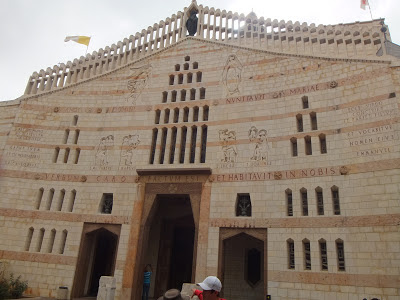 |
| Basilica of the
Annunciation in Nazareth |
LK 1:34 "How will this be," Mary asked the angel, "since I am a virgin?"
LK 1:35 The angel answered, "The Holy Spirit will come upon you, and the
power of the Most High will overshadow you. So the holy one to be born will
be called the Son of God. 36 Even Elizabeth your relative is going to have a
child in her old age, and she who was said to be barren is in her sixth
month. 37 For nothing is impossible with God."
The facade at the top level depict the angel Gabriel speaking to Mary.
At the second level from left to right are the Evangelists, Matthews,
Mark, Luke and John.
The current church is a two-story building constructed in 1969 over the
site of an earlier Byzantine-era and then Crusader-era church. The first
church was probably built by Emperor Constantine’s mother, Helena. She
also built the Church of the Nativity (the birthplace) and the Church of
the Holy Sepulchre (the tomb) at the same time period. This church was
destroyed in the 7th century.
The second church was built over the ruins of the Byzantine era church
during the Crusades, following the conquest of Nazareth by Tancred in
1102. The Crusader era church was never fully completed. When the land
came under Muslim rule, Saladin granted permission to Franciscan priests
to remain in Nazareth to oversee services at the church.
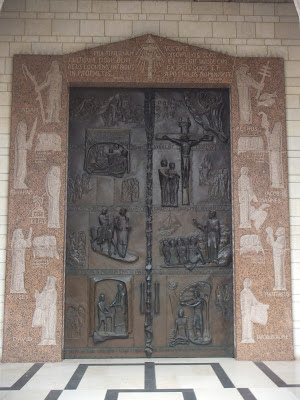 |
| large bronze front
door of the church with scenes of Jesus' life |
In 1260, Baybars and his Mamluk army destroyed the church during their
attack on Nazareth. A small number of Franciscans managed to stay in
Nazareth until the fall of Acre in 1291. In the three centuries that
followed, the Franciscans were in and out of Nazareth, depending on the
local political situation, which was constantly in flux. Franciscan
accounts of this period document their expulsion in 1363, their return
in 1468 and a massacre of some of their members in 1542.
Emir Fakr ad-Din granted the Franciscans permission to return in 1620.
In 1730, Dhaher al-Omar permitted construction of a new church, which
became a central gathering place for Nazareth Latin community. The
church was enlarged in 1877, and then completely demolished in 1954 to
allow for the construction of a new basilica, which was completed in
1969. It is the largest Christian sanctuary in the Middle East, and was
dedicated in 1964 by Pope Paul VI. (source:Wiki)
 |
| courtyard with St.
Joseph's Church in the background and a convent on the right |
 |
| stature of Mary in
the courtyard |
Luke 1:38 "I am the Lord's servant," Mary answered. "May it
be to me as you have said." Then the angel left her.
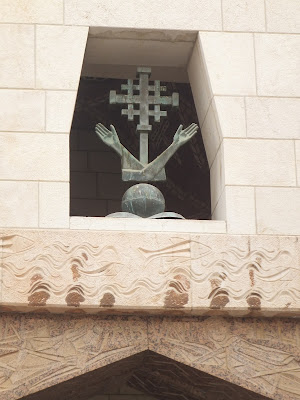 |
| bronze sculpture
in an alcove over one of the side front door. a pair of hands and
the Jerusalem Cross |
 |
| Madonna and Child |
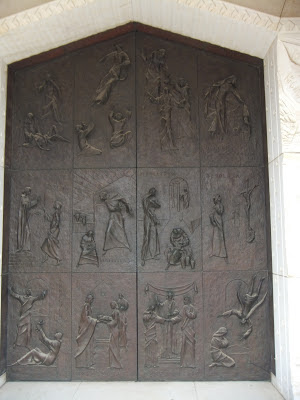 |
| another large
bronze gate with more scenes from Jesus' life |
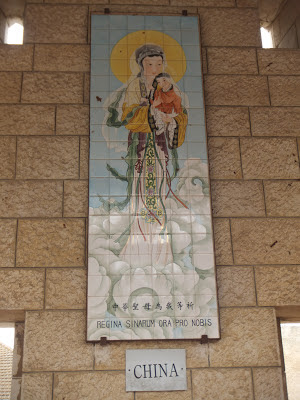 |
| mosaic picture of
Mary from China. there are many different mosaics from different
countries |
My good friend, Dr Sherman Kuek, Permanent deacon of the Catholic Church,
Secular Franciscan and theologian and Director of the Diocesan Pastoral
Institute helps me to understand the symbols of this mosaic.
The A and M stand for "Ave Maria", which means "Hail Mary". The
crown on the top alludes to the coronation of the Blessed Virgin
upon her assumption into heaven (ref. Revelation 12:1). Among
Catholics, one affectionate title given to her is "Queen of Heaven".
The Lily (together with the Rose of Sharon) image was used by St
Jerome and is taken from the Song of Solomon (also known as the Song
of Songs), “I am the Rose of Sharon and the Lily of the Valleys”
(2:1). These images suggested the Virgin Mary's purity and beauty.
The image of a rose with petals not fully opened was connected to
her virginity and youth. Just as young flower does not open
completely until it has reached maturity, the Virgin Mary was chosen
to become the Mother of God when she was still a pure, young girl.
I am uncertain on whether the bird is a dove or just any other
normal kind of bird. If it is a dove, it would refer to Mary's
wisdom ("Mater Sapientia"), purity and gentleness. If it is just
generally a bird, it signifies the human soul, probably to state
that Mary was human and not divine.











